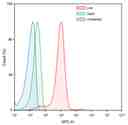Cell Explorer™ Live Cell Labeling Kit *Red Fluorescence*
Example protocol
AT A GLANCE
- Prepare cells in growth medium
- Remove the medium
Add Calcein Deep Red™ working solution (100 µL/well for 96-well plates or 25 µL/well for 384-well plates)
- Incubate cells at 37°C for 30 minutes to 2 hours
- Wash the cells
- Examine the specimen under under fluorescence microscope with Cy5 filter (Ex/Em = 646/660 nm)
Thaw all the components at room temperature before starting the experiment.
CELL PREPARATION
For guidelines on cell sample preparation, please visit https://www.aatbio.com/resources/guides/cell-sample-preparation.html
PREPARATION OF STOCK SOLUTIONS
Unless otherwise noted, all unused stock solutions should be divided into single-use aliquots and stored at -20 °C after preparation. Avoid repeated freeze-thaw cycles
Add 20 µL of DMSO into the vial of Calcein Deep Red™ (Component A) and mix well to make Calcein Deep Red™ stock solution. Note: 20 µL of Calcein Deep Red™ stock solution is enough for 1 plate. Note: Unused Calcein Deep Red™ stock solution can be aliquoted and stored at < -20 °C for 2 weeks if the tubes are sealed tightly. Avoid repeated freeze-thaw cycles and protect from light.
PREPARATION OF WORKING SOLUTION
Add 20 µL of Calcein Deep Red™ stock solution into 10 mL of HHBS (Component B) and mix well to make Calcein Deep Red™ working solution. Protect from light.
SAMPLE EXPERIMENTAL PROTOCOL
- Remove the growth medium from the cell plates. Note: It is important to remove the growth medium in order to minimize the background fluorescence and increase the signal to background ratio.
Add 100 µL/well (96-well plate) or 25 µL/well (384-well plate) Calcein Deep Red™ working solution into the cell plate.
- Incubate the cells in a 37°C, 5% CO2 incubator for 30 minutes to 2 hours.
Remove the Calcein Deep Red™ working solution from the cells.
- Wash the cells with HHBS (Component B) for 2 to 3 times, and replace with HHBS.
- Image the cells using a fluorescence microscope with Cy5 filter (Ex/Em = 646/660 nm).
Spectrum
Product family
| Name | Excitation (nm) | Emission (nm) |
| Cell Explorer™ Live Cell Labeling Kit *Green Fluorescence* | 494 | 514 |
Citations
Authors: Cemma, Marija and Grinstein, Sergio and Brumell, John H
Journal: Autophagy (2016): 1440--1446
Authors: Hu, Qing and Li, Yuli and Miao, Guohou and Zhao, Naru and Chen, Xiaofeng
Journal: Rsc Advances (2014): 22678--22687
Authors: Myung, Ja Hye and Gajjar, Khyati A and Chen, Jihua and Molokie, Robert E and Hong, Seungpyo
Journal: Analytical chemistry (2014): 6088--6094
Authors: Lei, Bo and Chen, Xiaofeng and Han, Xue and Zhou, Jiaan
Journal: Journal of Materials Chemistry (2012): 16906--16913
References
Authors: Gough AH, Johnston PA.
Journal: Methods Mol Biol (2007): 41
Authors: Hoffman AF, Garippa RJ.
Journal: Methods Mol Biol (2007): 19
Authors: Giuliano KA., undefined
Journal: Methods Mol Biol (2007): 189
Authors: Taylor DL., undefined
Journal: Methods Mol Biol (2007): 3
Authors: Haasen D, Schnapp A, Valler MJ, Heilker R.
Journal: Methods Enzymol (2006): 121




